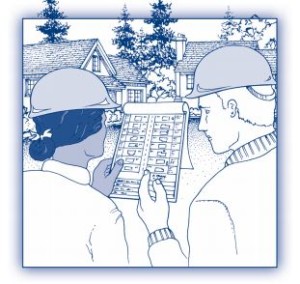Disasters are major events that can strike anywhere and at any time. In a disaster, traditional 9-1-1 and First Responder capabilities such as fire, police, medics, and utility personnel will be overwhelmed and unable to immediately assist individuals. Therefore, preparing our community for a disaster is important. Neighbors will likely be the first ones to offer you assistance. Neighbors that are prepared are more effective in their response to a disaster and have an increased capacity to be self-sufficient for the first 72 hours after a disaster.
 |
Map Your Neighborhood (MYN) is a program designed to help neighborhoods prepare for disasters and is offered through many local emergency management offices. Download the brochure and print a copy for your home. |
MYN will help you to:
•Learn the “9 Steps to Take Immediately Following a Disaster” to secure your home and to protect your neighborhood. It is hard to think clearly following disaster and these steps will help you to quickly and safely take actions that can minimize damage and protect lives.
•Identify the Skills and Equipment each neighbor has that would be useful in an effective disaster response. Knowing which neighbors have supplies and skills helps your disaster response be timely, and allows everyone to contribute to the response in a meaningful way.
•Create a Neighborhood Map identifying the locations of natural gas and propane tanks for quick response if needed.
•Create a Contact List that helps identify those with specific needs such as elderly, disabled, or children who may be home alone during certain hours of the day.
•Work together as a team to evaluate your neighborhood during the first hour following a disaster and take the necessary actions.
9 Steps Immediately Following a Disaster
At Home…
Step 1: Take care of your loved ones
Step 2: Protect your head, feet and hands. A bicycle helmet or hard hat protects from falling debris. Sturdy shoes protect from broken glass. Leather gloves protect from sharp objects.
Step 3: Check the natural gas at your home. Shut off if necessary. This is one of the best ways to prevent fire.
Step 4: Shut off water at the house main to trap water in your home and to keept pollutants out of possible drinking water, like that in your water heater.
Step 5: Place the HELP or OK sign on your front door or window. Posting the sign helps your neighbors locate those who need help first.
Step 6: Put your fire extinguisher on the sidewalk or where neighbors can see it. This way, if a neighbor has a small fire after a disaster, extinguishers are immediately available.
With Neighbors…
Step 7: After Steps 1-6 are completed, go to the Neighborhood Gathering Site.
Step 8: Form Teams at the Neighborhood Gathering Site:
•Team 1 will listen to the Emergency Alert System (AM/FM radio) or to a NOAA Weather Radio and keep neighbors informed of what they learn.
•Team 2 will check on neighbors who are elderly, those with disability, or children who may be home alone.
•Team 3 will check all natural gas meters and propane tanks and shut off gas if necessary.
•Team 4 will check on all homes with the “HELP” card displayed on the front door or window, or with no card showing. Be prepared to give first aid. Trust your instincts. If something feels unsafe, stay out.
Step 9: After your team has completed its work, go back to the Neighborhood Gathering Site and share what you have done with the rest of the neighbors.
